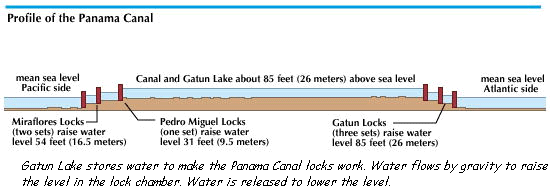
A great water tollway, often called the "Big Ditch," links the Atlantic and Pacific oceans. It weaves across a strip of tropical land where the Isthmus of Panama narrows in the shape of a long flattened letter S. The fame of the Panama Canal is not in its size, for it is only about 51 miles long. The Big Ditch is an engineering triumph over nature. It has also been a major influence on world trade.

About 32 oceangoing vessels pass through the canal daily. They pay an average of $28,000 for passage. Some massive ships pay tolls several times this amount. The fees are well spent, for the trip of some eight to ten hours through the canal saves many miles and many days of travel. If there were no Panama Canal, a ship going from San Francisco, Calif., to New York City would have to sail down around the tip of South America, an additional 7,900 nautical miles--some of it in very rough seas. Refrigerated cargo ships from Australia use the Panama Canal as a shortcut in voyages to Great Lakes ports, via the St. Lawrence Seaway.
An almost endless variety of commodities passes through the canal day after day. About 140 million tons of oceangoing commercial cargo are shipped through the canal in a single year. The main commodity group--petroleum and petroleum products--makes up about 22 percent of the annual cargo tonnage; grains compose about 16 percent. A significant development in canal cargo has been the increase in automobile trade. Over 2.4 million tons of automobiles are moved through the canal every year, most being transported from Japan to the United States.

Vessels using the canal sail under the flags of more than 70 nations. A small percentage of the world's water shipping is routed through the canal. The greatest user is the United States, which transports much of its imports from Latin American neighbors through the watercourse.
In fiscal 1915, the first year of operation, about 5 million tons of cargo were shipped through the Panama Canal. In 1924, 27 million tons were carried through it. Between 1925 and 1941 the annual tonnage varied between 18 million and 31 million. There was a dip in total cargo during World War II, but since then nearly every year has shown an increase. The figure for 1950 was some 30 million tons. By the early 1960s the volume had almost doubled. During the late 1960s, largely as a result of the Suez Canal blockade, tonnage rose to well over 100 million tons annually
The locks of most canals elsewhere in the world are used for a single purpose--either to move ships up to a higher body of water or to move them down to a lower body. The Panama locks, however, literally take ships up the side of a hill and down again. From the air the locks look like giant steps. They are built in pairs for two-way traffic or, occasionally, parallel traffic in the same direction.
A ship from the Atlantic side enters the first Gatun lock chamber at sea level. Huge miter gates close behind. The gates are seven feet thick, with compartments of concrete. The largest of the Panama Canal gates, at Miraflores, weigh some 730 tons. They are 82 feet high, as tall as a six-story building. Despite their size the gates are delicately balanced on their pintles. A 25-horsepower motor can swing them. A fender chain is raised to protect the gates against damage by a ship. Each chain weighs more than 15 tons. Each link alone weighs 70 pounds. The chains are hydraulically controlled. If they are struck by a ship, the fender chains yield to lessen the blow.

A lockmaster walks on the wall beside the ship. Only on his order are the locks opened or closed or the water level changed. He uses hand signals or a telephone to give orders to the control house operator. In the control house the operator watches indicators arranged on a miniature set of locks. When he presses a switch to open a pair of the giant lock gates outside, a pair of tiny gates on the control table duplicates the action. Indicators show the degree of opening of the water valves and the height of the water in each lock chamber.
Length, 51 miles from deep water to deep water. Minimum width of the navigable channel is 500 feet.
LocksSix pairs, or a total of 12. Each is 1,000 feet long and 110 feet wide. Normal permissible transit draft is 391/2 feet of tropical fresh water. The lock system lifts ships to 85 feet above sea level.
ConstructionWork begun by United States May 4, 1904. Opened for traffic Aug. 15, 1914. Earth and rock excavated before opening, 239 million cubic yards. Initial cost, $380,000,000.
Approximate distances saved (in nautical miles)New York City to San Francisco, Calif., 7,900; Liverpool, England, to San Francisco, 5,600; New York City to Yokohama, Japan (compared with a Suez Canal route), 3,300.
TollsLaden merchant ships, $1.83 per measurement ton. (A Panama Canal measurement ton is each 100 cubic feet of space usable for revenue.) Ships in ballast, without cargo or passengers, $1.46 per measurement ton. Special vessels, $1.02 per displacement ton (each long ton--2,240 pounds--of water displaced).
GovernmentIn 1979 Panama Canal Commission, with joint U.S.-Panamanian membership, replaced Panama Canal Company, whose ex officio president had been U.S.-appointed governor of Canal Zone.